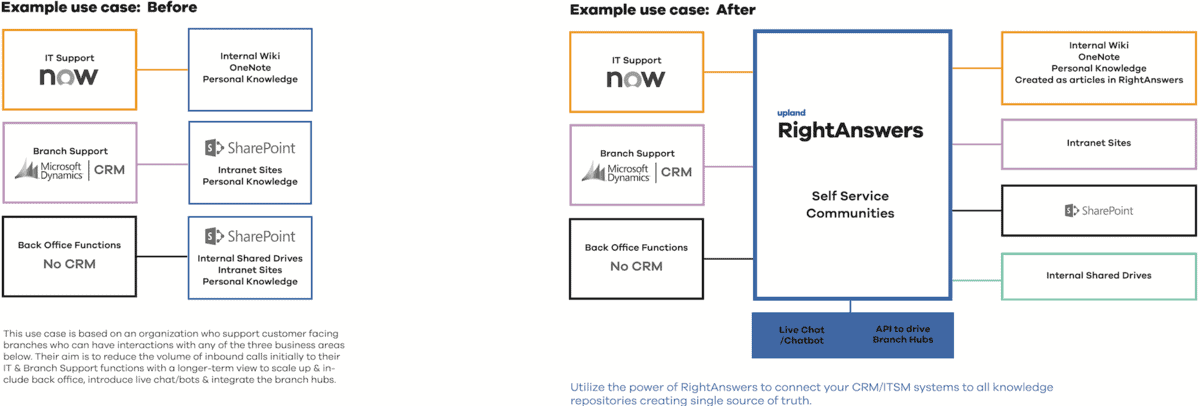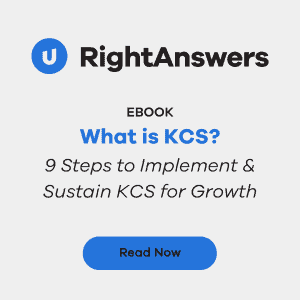What is Connected Knowledge and why do I need it?
One of the things I love most about Knowledge Management is that it all revolves around keeping things simple. Managing to do that is an art in itself and once you have mastered the fundamentals, the benefits can be appreciated across a business unit or an entire organization.
If you’ve ever heard me speak about setting yourself up for success with Knowledge Management, you will recognise the three core principles that I think are essential.
#SingleSourceOfTruth
#ClicksToContent
#TeamworkMakesTheDreamWork
I usually don’t miss an opportunity to talk about these in depth however, for the purpose of this blog, I want you to know that all three of these can be applied to both processes and tools (see, keeping it simple already).
One of the main challenges Knowledge Management professionals encounter when looking to improve an organizations KM practices, is how many different repositories can exist. If it is zero, even though the challenge is real, it can be quickly rectified by creating one and if you adopt KCS™ methodology, you will start to see how quick it can be to turn unknown issues into known fixes. This in turn populates your knowledgebase quickly with relevant information that speeds up resolution for both internal and external users.
When there is just one repository, if it is well maintained and it is at the heart of a knowledge sharing culture, congratulate the person who has driven that, honestly there would have been a lot of planning and effort in achieving this.
When you come across multiple repositories the challenges start to mount up, couple that with not having anything in place to promote collaborative working, the quality of information given to a customer can start to drop.
Why are multiple repositories a problem, surely having more knowledge available in different places is good right?
The simple answer to that is, only if they are maintained and easily accessible.
The risk comes in when you do not connect all your repositories and the user gets different knowledge from the multiple sources. Think about how frustrating it is when you cannot get a consistent answer to the same question when you most need it. We’ve all been there as customers, waiting while an agent puts you on hold as they go to find information, sometimes contradicting themselves in the process.
Think back to when that has happened and try to remember how that made you feel about the organization you had the interaction with. I’m sure you would appreciate a more focused interaction where the agent came across as an expert who resolved your query in a timely manner.
Having a single source of truth is the foundation to build your KM programme on, this is where the concept of Connected Knowledge really starts to make it simple.
In our personal lives, when we want answers to our questions quickly, we don’t open tabs for different search engines to see what we can find on each. The overwhelming majority will go to their trusted search engine which will bring back the results based on the search term. One window with all the results from all the different sources that are available, simple.
Try it after you have finished reading this blog, even the most tech savvy of us will take anything from 10 – 20 seconds per search at a natural speed. If we multiply that by the different repositories a user has to search in with time added for applications that don’t have the strongest search capabilities, you start to see how much time is being taken to find that key piece of information that will result in answering the customers query.
Now consider how much pressure is being applied to the agent taking the call. They have to balance the conversation with the customer with the task of finding and reading a relevant article, all within the target handling time. In a role where you are being measured on traditional metrics like handling time, first call resolution and customer experience, the time to find the right answer holds even more importance.
If we truly consider frontline service agents as key workers, shouldn’t we be trying to make their toolset as efficient as possible?
This is exactly what can be done with RightAnswers, a powerful federated search that crawls all the repositories you have set up to return the most relevant content in one window. Imagine the time that could be saved by not having to go from source to source to see if what you need is there, this is the power of Connected Knowledge.
Bringing the information together is the first and most basic principle of Connected Knowledge, the next is how to deliver the articles to the user.
RightAnswers has been built to not only to have its own portal but also to be integrated into other tools to allow robust access to native and federated knowledge, all in the same window that the user operates in most of the time.
This includes popular ITSM/CRM tools out of the box such as ServiceNow, Salesforce, MSDynamics, BMC Remedy Cherwell to name a few. In addition to this, our APIs open up integration possibilities with other tools with some slight configuration, more on that later.
The advantage of having RightAnswers integrated into the users workflow is, it allows them to get to the articles they need in the quickest way by having the results in their line of site, right within the host application. Pulling in the search term from the description the agent types in the case record, again shaves off valuable seconds to the overall handling time of the interaction, as does attaching the article to the case record with a simple click. These small time savings add up over time and number of users, resulting in more customers being served quicker.
If you’ve read one of my previous blogs ‘Who needs Knowledge?’, the next revelation will come as no surprise, having a Knowledge Management tool that can perform across your organization will bring a multitude of benefits to each area.
Again, this is an area where RightAnswers excels, the ability to integrate into multiple tools within an organization and allow common articles to be shared with all, while segregating content for specific business units. Below is a before & after example to demonstrate how Connected Knowledge can help across an enterprise (based on an actual use case).
 From the customer perspective, the above example shows how they will have access to the same information regardless of which channel they use. The knowledgebase becomes the single source of truth, so even if the customer has multiple questions traditionally answered by different departments, the answer will be consistent regardless of the channel used.
From the customer perspective, the above example shows how they will have access to the same information regardless of which channel they use. The knowledgebase becomes the single source of truth, so even if the customer has multiple questions traditionally answered by different departments, the answer will be consistent regardless of the channel used.
It opens up the possibility of a multi skilled workforce, agents will be able to give available information without having to transfer for simple enquiries. This can drastically improve performance against traditional KPIs, the customer also spends less time on the phone and can enjoy their personal time.
Less time on calls + knowledgeable agents = positive NPS scores.
Taking the enterprise approach can empower organizations to create a company wide knowledge sharing culture and work more efficiently between business units too.
Think of the time saved by a frontline agent who needs to find out about a HR query while they are on a break. Instead of having to switch between 2 or 3 different applications with different functionality, they would be able to access the article through a familiar application and if need be, bookmark the article for future reference. Giving users more reasons to use a knowledgebase helps drive adoption, especially if it can have a personal benefit to them.
I’m guessing that you are starting to see the benefits Connected Knowledge can bring to an organization but wait, there’s more.
There are occasions where even though you may read an article that is helpful, you are left with additional questions that require a discussion. This is where Communities come in to play. With RightAnswers we take the concept of Communities seriously as a tool to connect users with experts to overcome challenges.
Instead of a paragraph on the mechanics of how they work & how flexible they are, I will keep it simple and let you know that once an answer in the community is accepted, it kicks starts the article creation process by creating a draft out of the conversation, ready for it to be completed and published. Connecting users and harvesting relevant knowledge from interactions will again improve customer experience.
The final piece of the Connected Knowledge puzzle is the use of our APIs to inject the benefits of RightAnswers into other tools. This can include connecting Chat Bots to leverage the knowledgebase or powering external self-service sites with knowledge from the single source of truth, while looking native to the UI of the host site. The key here is flexibility, being able to choose how you want to connect knowledge to meet the needs of your users.
User experience is at the heart of the Connected Knowledge concept, what is the benefit of having knowledge if it is not easily accessible. In a world so heavily reliant on technology, we must always remember the output of Knowledge Management is to serve people. Ensuring we can connect people and tech in ways that reduce the cognitive load and energy taken to surface the right answers, is essential to any organizations success.
Now that you have more knowledge on what Connected Knowledge is, feel free to connect with us (see what I did there) to discuss how we can help bring your KM programme together.



